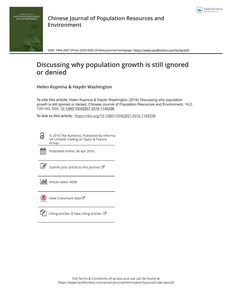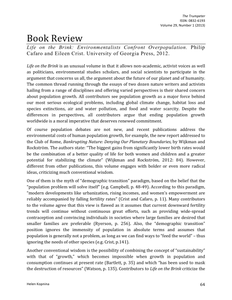During the COVID-19 pandemic, the bidirectional relationship between policy and data reliability has been a challenge for researchers of the local municipal health services. Policy decisions on population specific test locations and selective registration of negative test results led to population differences in data quality. This hampered the calculation of reliable population specific infection rates needed to develop proper data driven public health policy. https://doi.org/10.1007/s12508-023-00377-y
MULTIFILE

Due to a number of factors outlined in this article, the issue of population growth is excluded from the sustainability discussion. In this article, we explore some of the ethical presumptions that underlie the issues linking population growth and sustainability. Critics argue that action to address population creates social and economic segregation, and portray overpopulation concerns as being “anti-poor,” “anti-developing country,” or even “antihuman.” Yet, de-linking demographic factors from sustainability concerns ignores significant global realities and trends, such as the ecological limits of the Earth, the welfare and long-term livelihood of the most vulnerable groups, future prospects of humanity, as well as the ecosystems that support society. https://doi.org/10.1080/10042857.2016.1149296 LinkedIn: https://www.linkedin.com/in/helenkopnina/
MULTIFILE

Background Ethnic differences in colon cancer (CC) care were shown in the United States, but results are not directly applicable to European countries due to fundamental healthcare system differences. This is the first study addressing ethnic differences in treatment and survival for CC in the Netherlands. Methods Data of 101,882 patients diagnosed with CC in 1996–2011 were selected from the Netherlands Cancer Registry and linked to databases from Statistics Netherlands. Ethnic differences in lymph node (LN) evaluation, anastomotic leakage and adjuvant chemotherapy were analysed using stepwise logistic regression models. Stepwise Cox regression was used to examine the influence of ethnic differences in adjuvant chemotherapy on 5-year all-cause and colorectal cancer-specific survival. Results Adequate LN evaluation was significantly more likely for patients from ‘other Western’ countries than for the Dutch (OR 1.09; 95% CI 1.01–1.16). ‘Other Western’ patients had a significantly higher risk of anastomotic leakage after resection (OR 1.24; 95% CI 1.05–1.47). Patients of Moroccan origin were significantly less likely to receive adjuvant chemotherapy (OR 0.27; 95% CI 0.13–0.59). Ethnic differences were not fully explained by differences in socioeconomic and hospital-related characteristics. The higher 5-year all-cause mortality of Moroccan patients (HR 1.64; 95% CI 1.03–2.61) was statistically explained by differences in adjuvant chemotherapy receipt. Conclusion These results suggest the presence of ethnic inequalities in CC care in the Netherlands. We recommend further analysis of the role of comorbidity, communication in patient-provider interaction and patients’ health literacy when looking at ethnic differences in treatment for CC.
LINK
Vergelijking van de sportdeelname in de 25 landen van de Europese Unie, met een systematisch overzicht van de beschikbare sportparticipatiegegevens per land. Ook besteedt het boek aandacht aan de 'key drivers' van sportparticipatie en aan de kansen en valkuilen van beleidsinterventies gericht op verhoging van de sportparticipatie.
DOCUMENT

BACKGROUND: Frailty is often associated with multimorbidity and disability. OBJECTIVES: We investigated heterogeneity in the frail older population by characterizing five subpopulations according to quantitative biological markers, multimorbidity and disability, and examined their association with mortality and nursing home admission. DESIGN: Observational study. PARTICIPANTS: Participants (n=4,414) were from the population-based Age Gene/Environment Susceptibility Reykjavik Study. MEASUREMENTS: Frailty was defined by ≥ 3 of five characteristics: weight loss, weakness, reduced energy levels, slowness and physical inactivity. Multimorbidity was assessed using a simple disease count, based on 13 prevalent conditions. Disability was assessed by five activities of daily living; participants who had difficulty with one or more tasks were considered disabled. Differences among frail subpopulations were based on the co-presence of multimorbidity and disability. Differences among the following subpopulations were examined: 1) Non-frail (reference group); 2) Frail only; 3) Frail with disability; 4) Frailty with multimorbidity; 5) Frail with disability and multimorbidity. RESULTS: Frailty was present in 10.7% (n=473). Frailty was associated with increased risk for mortality (OR 1.40; 95% CI 1.15-1.69) and nursing home admission (OR 1.50; 95% CI 1.16-1.93); risks differed by subpopulations. Compared to the non-frail, the frail only group had poorer cognition and increased inflammation levels but did not have increased risk for mortality (OR 1.40; 95% CI 0.84-2.33) or nursing home admission (OR 1.01; 95% CI 0.46-2.21). Compared to the non-frail, the other frail subpopulations had significantly poorer cognition, increased inflammation levels, more white matter lesions, higher levels of calcium, glucose and red cell distribution width and increased risk for mortality and nursing home admission. CONCLUSIONS: The adverse health risks associated with frailty in the general older adult population may primarily be driven by increased disease burden and disability.
DOCUMENT
The higher education sector has become increasingly aware of how the increasing diversity in society affects their institutions. The student population has become more diverse and future employers increasingly require trained students who are able to meet the demands of dealing with a more diverse market/clientele. In this regard, education institutions need to align their strategic approach to diversity within their organization. The purpose of this paper is to examine strategical reasons to diversify in different education teams in relation to two different diversity practices: attraction and selection of culturally diverse lecturers and utilization of cultural differences in team interaction.
LINK
The so called Second Demographic Transition (Lesthaeghe and Van der Kaa, 1986), which surfaced in the sixties of the twentieth century in Western Europe and North America, resulted from a significant change in the pattern of norms and values. This again resulted in delayed fertility, a declining population when there was no replenishment through "replacement migration” and an increasing variety of household structures (with a rising number of one-person households). The rise in life expectancy coupled with a declining fertility, evolved into a gradual ageing of the population.The concept of ‘unbalanced population decline’ (Van Nimwegen and Heering 2009) enables us, while studying population decline, to take into account different motives underlying the decision to migrate during the life course; young people migrating in search of higher education and job opportunities and elderly clustering in places with a high facility level. This unbalanced population decline is taking place in some rural parts and smaller towns in the Netherlands. Especially the two migration flows mentioned above determine the structure of the population and the possibilities for effective family, kin and other social support systems for the elderly.Method:Analysis using amongst others recent demographic data from de community of Oldambt (Netherlands)Results:It will be shown that the effects of the demographic transition in the North of the Netherlands are accelerated because of unbalanced population decline. Furthermore it will be argued that because of this combination in parts of the Northern Netherlands family, kin and social support systems for the elderly are deteriorating more rapidly than in other parts of the county.Conclusion:Combined effects of demographic transition and unbalanced population decline urge for a reconsideration of the possibilities to rely on family, kin and other social support systems in different regions in the Netherlands.
DOCUMENT
At present, leading international agencies, such as the United Nations Environmental Programme, are largely focused on what they claim to be ‘win-win’ scenarios of ‘sustainable development’ rhetoric. These combine social, economic and environmental objectives. However, as noted by the ‘Scientists’ Warning to Humanity’, environmental integrity is the essential precondition for the healthy functioning of social and economic systems, and thus environmental protection needs to be prioritized in policy and practice. Ecological sustainability cannot be reached without realizing that population growth and economic growth, with attendant increased rates of depletion of natural resources, pollution, and general environmental degradation, are the root causes of unsustainability. This article argues that to strategically address ecological unsustainability, the social, economic and political barriers to addressing the current economic model and population growth need to be overcome. Strategic solutions proposed to the current neoliberal economy are generic – namely, degrowth, a steady-state economy, and a ‘circular economy’. Solutions to demographic issues must be sensitive to the countries' cultural, social, political and economic factors to be effective as fertility differs from country to country, and culture to culture. As discussed here, Mediterranean countries have the lowest fertility in the world, while many countries in Africa, and some in Asia, South America have stable but consistently high birthrates. This is discussed using three case studies - Tanzania, Italy, and Cambodia, focusing on the "best case" policy practice that offers more realistic hope for successful sustainability. https://doi.org/10.1007/s41207-019-0139-4 LinkedIn: https://www.linkedin.com/in/helenkopnina/
MULTIFILE

Life on the Brink is an unusual volume in that it allows non-‐academic, activist voices as well as politicians, environmental studies scholars, and social scientists to participate in the argument that concerns us all, the argument about the future of our planet and of humanity. The common thread running through the essays of two dozen nature writers and activists hailing from a range of disciplines and offering varied perspectives is their shared concern about population growth. All contributors see population growth as a major force behind our most serious ecological problems, including global climate change, habitat loss and species extinctions, air and water pollution, and food and water scarcity. Despite the differences in perspectives, all contributors argue that ending population growth worldwide is a moral imperative that deserves renewed commitment. https://www.linkedin.com/in/helenkopnina/
DOCUMENT

By 2050, 70% of the population will live in cities. The majority of the persons living in cities will be 60 plus years old. Ageing cities demands for cities environments to adapt to an ageing population. Modern cities though, don’t anticipate fast enough and in an adequate manner to face the challenges due to population-related transitions. Modifying and adapting the built environment with a focus on the aged population could help to support older people facing functional and cognitive decline.
MULTIFILE
